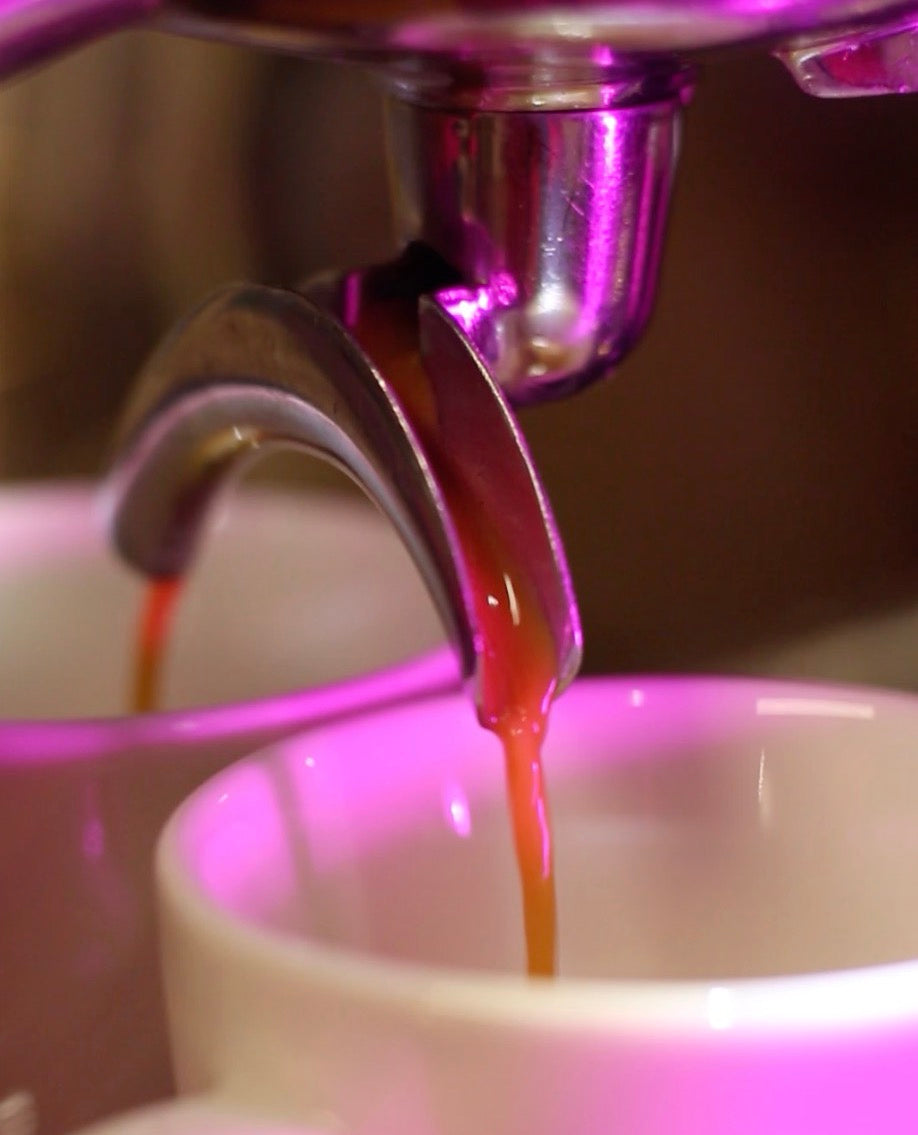Coffee Information
In this collaboration with Café 3Ciclos, we present a pair of coffees that, each on their own, deserve special treatment.
First up, we have the SL-28 Natural from Finca Villa Teresa . A variety selected in Kenya in 1935 by Scott Laboratories, characterized by its excellent cup quality, drought resistance, and extraordinary yield * . This batch—from Finca Villa Teresa in Huila, Colombia—went through an 80-hour anaerobic fermentation process, with rapid cherry drying in cement patios.
What is remarkable about this coffee is that it was processed as a natural, especially since it is a variety from Kenya, a country where virtually all coffee produced is processed as a washed coffee. In this case, the coffee exhibits clear fruit flavors, along with a characteristic bright and juicy acidity.
SL-28 Natural Villa Teresa Estate
Producer: Finca Villa Teresa
Country: Colombia.
Region: Huila, Palestine
Altitude: 1800 mts.
Variety: SL-28.
Post-harvest process: Fermentation in an anaerobic environment for 80 hours, cherry drying in the sun.
Harvest: October to December 2023.
Sensory Description
Dehydrated raspberry, violet hard candy, cranberry juice, milk chocolate, orange zest, lavender.
Bright and juicy acidity, medium-round sweetness and delicate low bitterness.
Medium body, velvety texture and clean finish.

On the other hand, we present again the Papayo Honey from Finca San Gabriel . This variety receives its name - according to various unverifiable sources - from the strange appearance of the cherry, whose shape resembles that of a papaya. Although its origin is usually attributed to a natural mutation of Bourbon, lately it has been said by various sources that it is a variety considered Ethiopian Landrace. However, the sources have been contradictory * , and in some cases, non-existent ** .
In the case of this batch, also produced in Huila, the cherry was processed as a honey —a process that involves partial pulping, which keeps traces of mucilage on the parchment during the drying time—, with an extended drying period of 120 hours. The marked flavors of spices and exotic fruit in this coffee are capable of attracting the attention of anyone who tries it; and make us question the information we have about the entire process.
Papaya Honey San Gabriel Farm
Producer: San Gabriel Farm
Country: Colombia.
Region: Huila, Palestine
Altitude: 1700 mts.
Variety: Papaya.
Post-harvest process: Drying in mucilage for 120 hours.
Harvest: September 2023.
Sensory Description
Pernod (anise liqueur), licorice, cloves, banana gum, gingerbread, white chocolate, cocoa nibs, cranberry syrup.
Medium acidity, high pronounced sweetness and low spicy bitterness.
Medium-heavy body, creamy texture and persistent finish.
Import
Both coffees were purchased directly from Manantial Coffee Chile , who imported them to Chile. The cost per kilo was CLP $21,301 (Papayo) and $26,061 (SL-28). This does not include operating costs, design or packaging —developed in conjunction with NoEstamosTrabajandoPara Usted—.
Roasting
In the case of this launch, since we were dealing with two different coffees and in search of a similar solubility in both, we decided to carry out tests in the Kaffelogic to predict the behaviour of both coffees when subjected to similar parameters.
Basically with the same profile, although with slight differences - a slightly lower final temperature for the SL-28 - we found that both coffees expressed themselves with a lot of juiciness and brightness, but with good balance and texture, particularly with quicker recipes.
SL-28 Natural Villa Teresa Estate
Toaster: Atilla GOLD II 5 kg.
Load: 3.45 kg.
Initial Humidity: -%
Total Time: 10 minutes, 40 seconds.
DTR: 13.6%
Final Temperature: 192 ºC
Accumulated Temperature*: 0.376
Mass loss: 12%

Papaya Honey San Gabriel Farm
Toaster: Atilla GOLD II 5 kg.
Load: 3.45 kg.
Initial Humidity: -%
Total Time: 10 minutes, 40 seconds.
DTR: 13.7%
Final Temperature: 192.5 ºC
Accumulated Temperature*: 0.378
Mass loss: 12%

*We calculate this value by dividing the area under the roasting curve by the load, ([ºC x min] / grams). We consider this value, in our roaster, to be a reasonable approximation of the development of the coffee, in a broad sense.
Water
All King Solomon coffees are cupped with water that follows the recipe below, which we recommend for the best possible results. If you prefer a simpler option, we recommend using Nomadic Waters , since that is the water we commonly use.
To get to the recipe below you need to first make a couple of mineral concentrates. We used the recipes from Barista Hustle . Our water recipe aims for the highest extraction possible, and a balance between acidity, sweetness and bitterness.
Recipe:
— 185 ppm** of Magnesium Sulfate ( MgSO₄ ); that is, 185 grams of the Hardness concentrate.
— 38 ppm** of Sodium Bicarbonate ( NaHCO₃ ), that is, 38 grams of Buffer concentrate.
— 777 grams of deionized, demineralized or distilled water.
**As an equivalent in CaCO3.
To make things simpler, we will soon be launching our own bottled water, ready to use. Stay tuned!
Preparation
In general, our coffees are designed for high extractions. However, in the case of these coffees, we chose to aim for recipes that exhibited a balance of body, complexity and clarity of flavors.
The idea of including recommended recipes is not to prevent you from experimenting with coffee, but to share the recipes with which we have had good results.
Manual percolation coffee makers ( conical or flat bottom, such as V60, Origami, Kalita Wave, Kono, etc.)
For these coffee makers, we made 3 recipes; specially designed for use in V60, but easy to adjust for other conical coffee makers. One for each coffee, and another for a mix of both. These recipes are in the box, but we leave them here too:
Water: 250 grams.
Drink: 215-225 grams.
Time: 2 - 3 minutes.
Temperature: 91ºC.
TDS: 1.4 - 1.5%
Second pour of 100 grams (150) at 30 seconds.
Last pour of remaining 100 grams (250) at 1 minute and 30 seconds. Move the coffee maker gently in circles for 3 seconds.
Water: 225 grams.
Drink: 195-205 grams.
Time: 2 - 3 minutes.
Temperature: 90ºC.
TDS: 1.4 - 1.5%
Second pour of 55 grams (100) at 30 seconds.
Pour the remaining 55 grams (225) at 1 minute and 30 seconds. Move the coffee maker gently in circles for 3 seconds.
Water: 330 grams.
Drink: 265-275 grams.
Time: 2 - 3 minutes.
Temperature: 89ºC.
TDS: 1.4 - 1.5%
Second pour of 135 grams (195) at 30 seconds.
Final pour of the remaining 135 grams (330) at 1 minute and 30 seconds. Move the coffee maker gently in circles for 3 seconds.
Immersion coffee makers (such as AeroPress, French Press, Hario Switch, Clever, etc.)
Dose: 18 grams.
Water: 250 grams.
Drink: 210-220 grams.
Time: 8 - 9 minutes.
Temperature: 94ºC.
TDS: 1.3 - 1.4%
[AeroPress, standard method]
Pour the 250 grams of water over the coffee, trying to pour as quickly and from as high as possible so as not to create any bumps on the surface of the water. Stir carefully, making sure to wet all the coffee evenly.
Insert the plunger without applying pressure to create a vacuum.
At 7 1/2 minutes, with the plunger still inserted, gently move the pot in a circular motion for 5 seconds.
At 8 minutes, begin pressing the plunger very gently for 30 to 60 seconds; press all the way down.
For other immersion coffee makers, use the same proportions and start filtering after 8 minutes. For a French press, leave the filter at the level of the drink's surface, do not press all the way to the bottom and pour gently.
It is recommended to first reach something close to these parameters with another coffee, and use the finest grind with which it is still easy to press the plunger smoothly.
Espresso
Dose: 20 grams.
Water: The water you use in your espresso machine, or the recipe indicated, if you have a machine that allows it easily.
Drink: 45-50 grams.
Time: 20-25 seconds.
Pressure from pump: 6 bar
Temperature: 90-92ºC
TDS: 8 - 9%
It is recommended to reach something close to these parameters beforehand with another coffee. Let the drink cool a little before tasting. For something like a allongé , use the same parameters, but aim for an 85-95 gram drink in about 30-40 seconds. For something like a sprover , aim for 220-230 grams in about 45-60 seconds.
Zero bypass coffee makers (Tricolate, LVL-10 and Pulsar)
Dose: 20 grams.
Water: 360 grams, recipe included.
Drink: 335 - 345 grams.
Time: 4-5 minutes.
Temperature: 91-93ºC.
TDS: 1.3 - 1.5%
[Press]
First pour —saturation or bloom— of 60 grams with the valve closed, move the coffee maker for 10 seconds ensuring that all the coffee is wet or stir carefully with WDT tool.
Pour 60 grams (120) at 30 seconds.
Open the valve to half flow (45°) after 60 seconds.
Pour the remaining 240 grams (360) in 5-7 pulses, each time until the water is 0.5-1 cm above the coffee level. Move the coffee maker gently in circles for 3 seconds after each pulse.
For the Next Level LVL-10, use 30 grams of coffee to 540 grams of water, with a slightly coarser grind; for the Tricolate, use between 15-25 grams of dose and maintain the ratio. For both machines, maintain bloom times.
For other zero-bypass coffee makers, keep the proportions but use the dosage recommended by the manufacturer. Try to do everything on a surface that allows you to keep the coffee maker level at all times. It is recommended to reach something close to these parameters beforehand with another coffee. In addition, it is recommended to keep the water boiling between pours.
Finally, to increase juiciness, it is recommended to increase the ratio to 1:15 - 1:16. To optimize the balance, it is recommended to decrease the ratio to 1:20 - 1:21.
Music
All of our coffees also come with a Spotify playlist, featuring songs we like to listen to while brewing and drinking. Generally, the songs we include in each playlist relate to some sensory aspect of coffee; but explaining exactly how they relate goes beyond words.
Listen to Collab Café 3Ciclos x King Solomon on Spotify.



